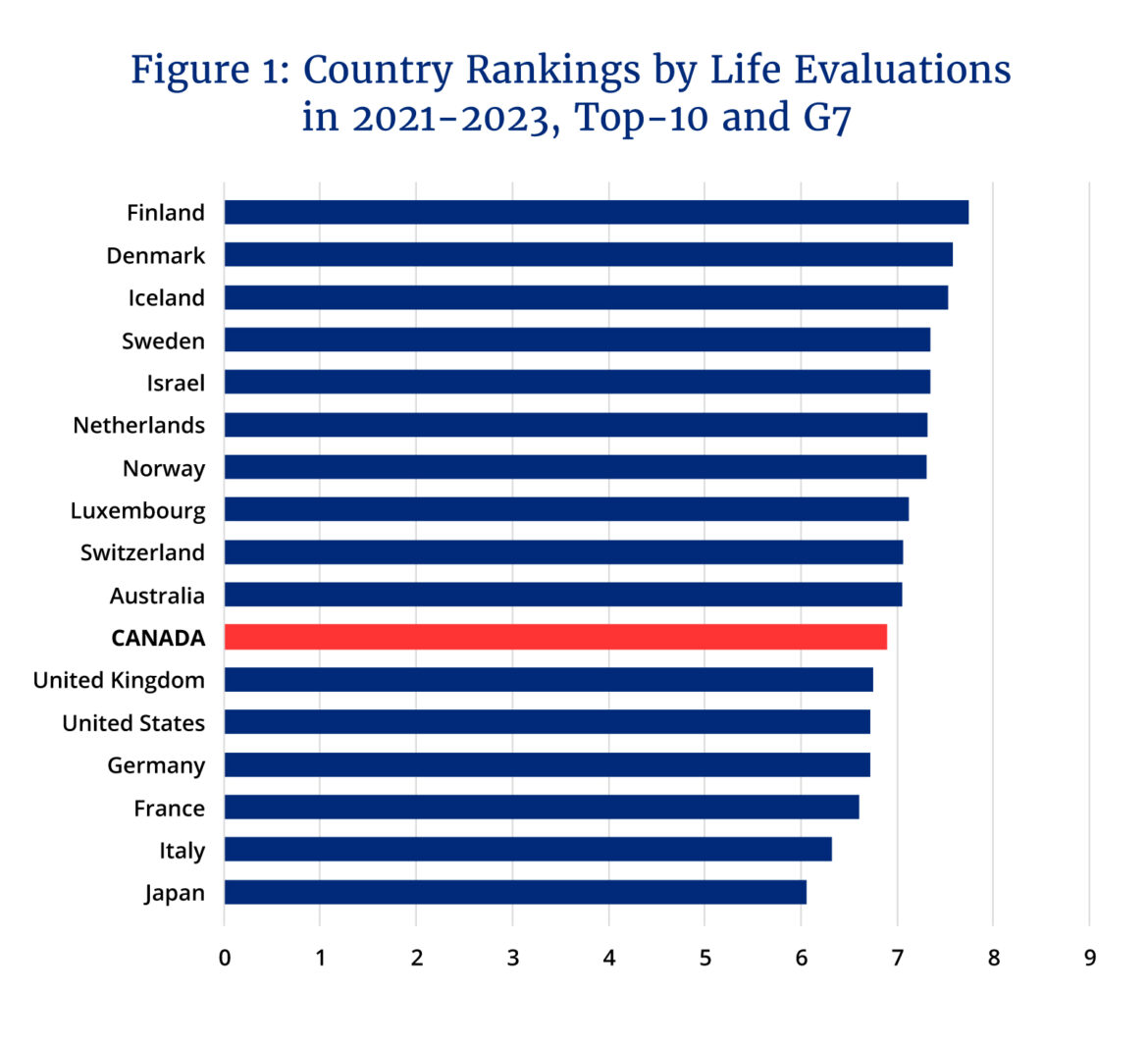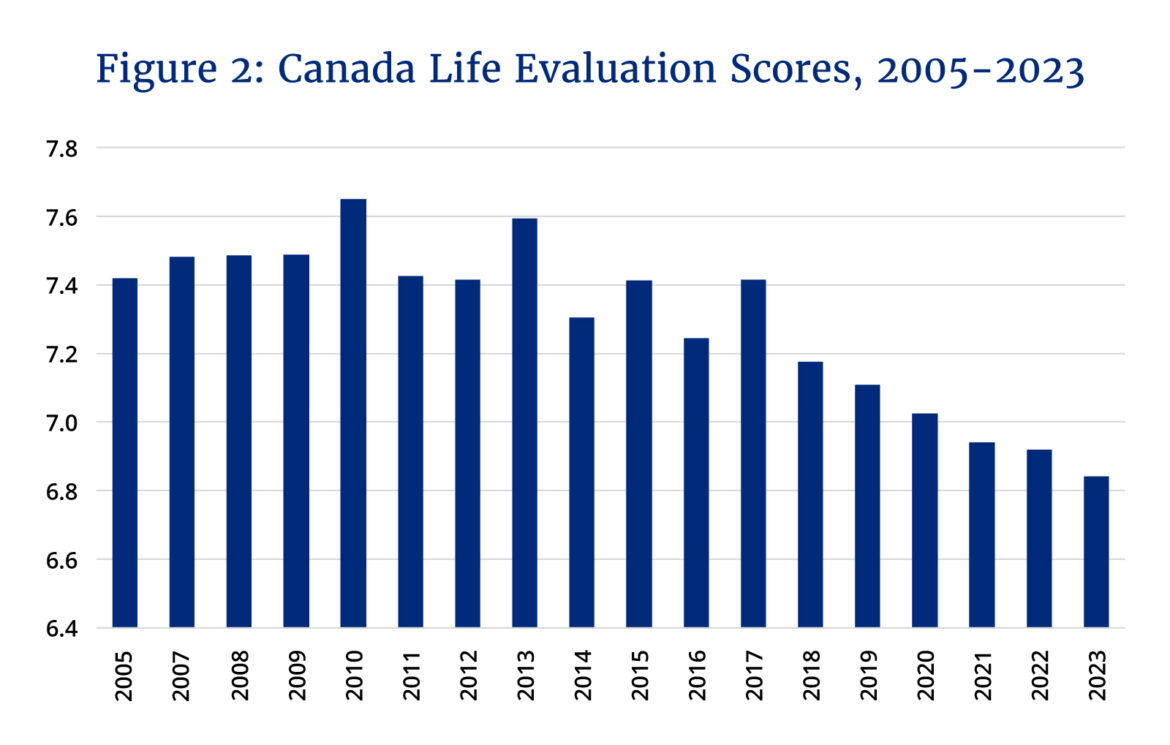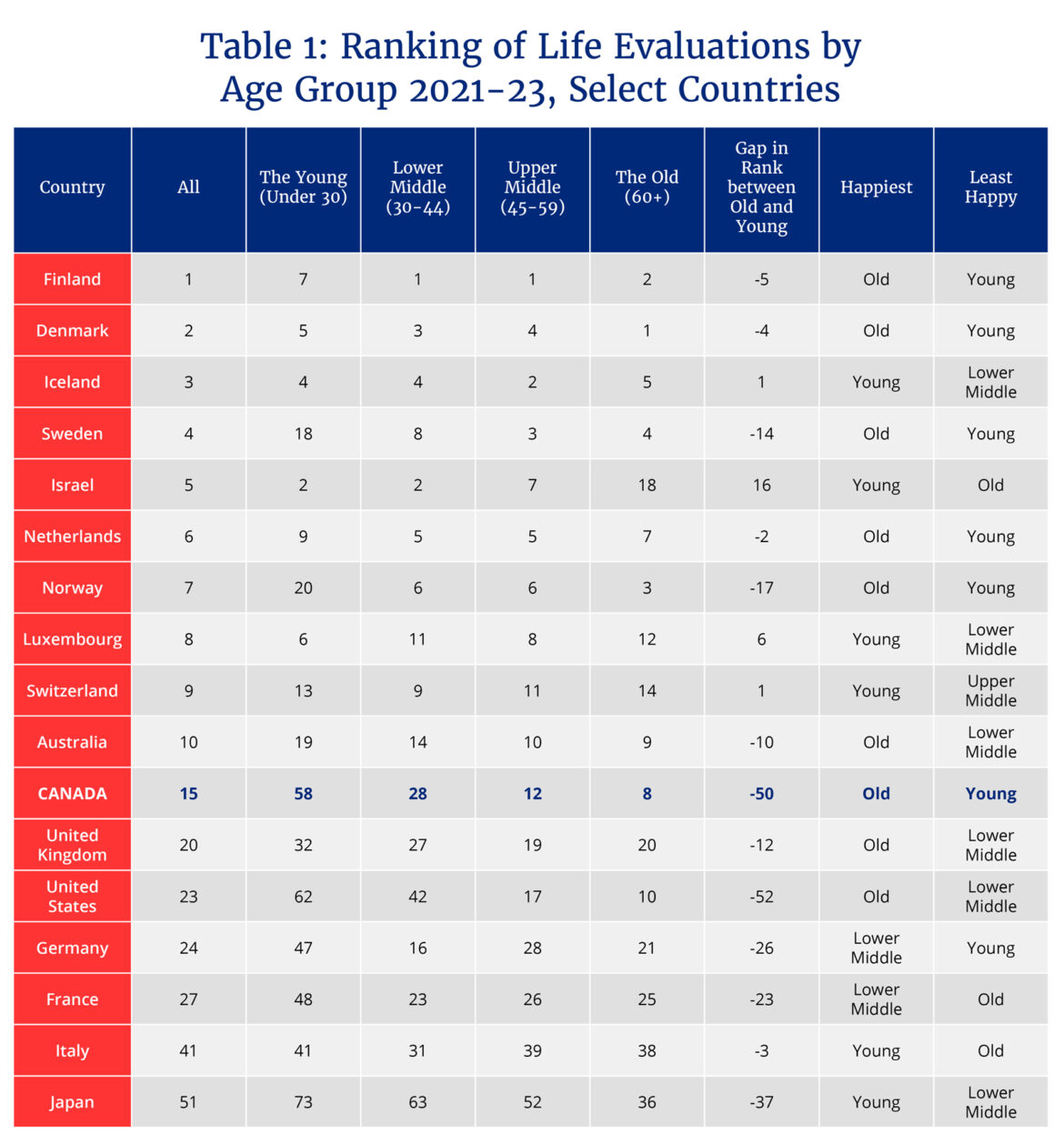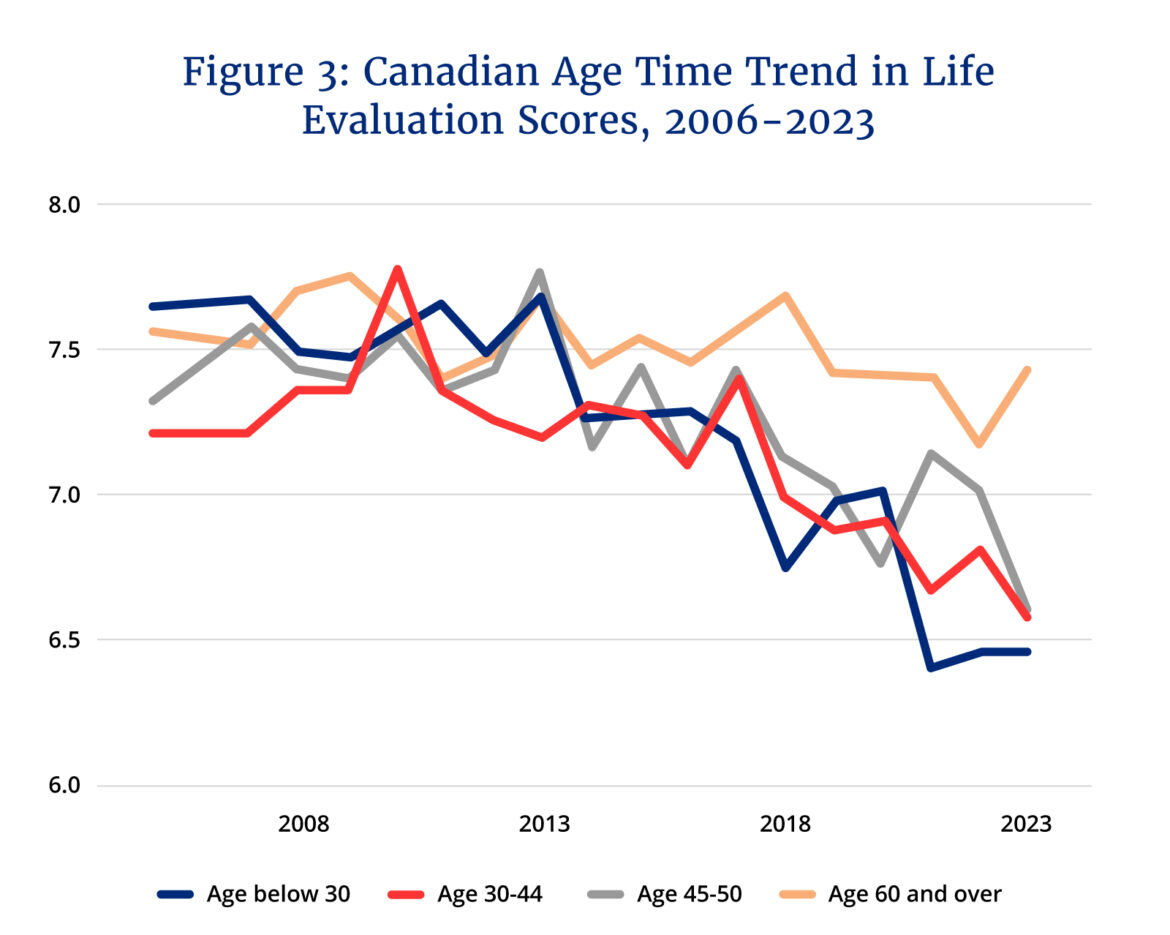
DeepDives is a bi-weekly essay series exploring key issues related to the economy. The goal of the series is to provide Hub readers with original analysis of the economic trends and ideas that are shaping this high stakes moment for Canadian productivity, prosperity and economic wellbeing. The series features the writing of leading academics, area experts and policy practitioners.
A key question pervading our politics is: how are Canadians doing?
Different voices have drawn on different evidence and sources of data to try to answer it. The two of us have recently pointed to Canada’s declining GDP per capita as evidence that the country has effectively experienced “a lost decade.” University of Calgary economist Trevor Tombe has similarly cited stagnant growth in income and wages as a sign that a sustained period of slow productivity has led to the “Great Canadian Slump.” Well-known American economist Tyler Cowen by contrast has argued that Canada’s GDP per capita hasn’t fallen as much as some have claimed. Former Trudeau adviser Tyler Meredith has referred to income gains over the past eight years—even though government transfers have played a significant role in producing such gains.
These different assessments of the country’s economic and social outcomes are further complicated by the sentiments of Canadians themselves. Polls indicate that about half of Canadians are living paycheque-to-paycheque and more than half are pessimistic about their long-run economic future, and yet about 44 percent still started 2024 with a sense of optimism relative to last year.
The upshot is that an assessment of the material progress and well-being of Canadians is somewhat complicated. Although we believe that on balance the data and evidence clearly point to a story of stagnation, we acknowledge that one can conceive of alternative facts. There are also distributional dynamics across age, class, and geographic lines that must be accounted for. The median person doesn’t actually exist.

In light of these types of analytical limitations, the notion has increasingly been advanced by various economists and social scientists that conventional economic metrics—including GDP, employment, income, and so on—don’t necessarily convey a textured understanding of what’s sometimes referred to as “human flourishing.” The argument here is that material well-being is a necessary yet insufficient condition for assessing one’s circumstances or outlook. Some scholars and thinkers instead point to happiness as the proper measure for socio-economic progress and even public policy itself.
This line of thinking has spawned a new body of research that one might describe as “happiness studies.” Although it itself is the subject of scholarly debate, the goal of the happiness scholarship is to draw on a diverse set of empirical metrics such as the Human Development Index, survey measures of subjective well-being, and human capabilities to evaluate and compare happiness between different societies and over time.
One of the best-known and most widely-regarded sources of happiness data is the World Happiness Report, which is an annual report produced by a consortium including Gallup, the Oxford Wellbeing Research Centre, the UN Sustainable Development Solutions Network, and the WHR editorial board. The latest report was released in late March 2024.
The purpose of this DeepDive is to analyse the strengths and weaknesses of happiness scholarship in general and Canada’s performance in the World Happiness Report in particular. The ultimate goal is to better understand the interrelationship between economic outcomes and happiness. Put differently: we aim to see if Canada’s “lost economic decade” has correlated with a decline in Canadians’ levels of self-reported happiness.
From GDP to happiness
Measures of economic well-being like Gross Domestic Product (GDP) per capita are important for understanding how a jurisdiction’s economy is performing in absolute and relative terms. But they also have their limits. They can be a bit crude and simple. Although they can tell us about the overall economy or even the socio-economic circumstances of those in different income groups, jobs, or places, they’re mostly silent on issues that define the human experience such as love, belonging, or purpose.
For instance, GDP may rise when there’s a lot of traffic congestion due to increased gasoline consumption, but if one asks drivers, more traffic jams invariably don’t improve their overall well-being. Similarly, certain types of economic activity such as online pornography may boost economic output but still have a deleterious effect on happiness, life satisfaction, and human flourishing.
Alternatively, economists are increasingly turning to measures of happiness or subjective well-being to capture a broader picture of social progress. The goal here to knit together different data sources or even forms of data collection to better understand how people feel about their lives, their futures, and the societies in which they inhabit.
Perhaps the leading scholar in the field is University of British Columbia economist John Helliwell. His longstanding work on personal happiness has been rooted in a couple of key axioms: namely, (1) subjective well-being and self-assessments are “authentic measures that deserves to be taken very seriously by anyone trying to see how a community or society works” and (2) past a certain point, higher incomes don’t correlate with higher levels of happiness.
Helliwell and his coauthors’ definition of happiness moves beyond measures of income rooted in GDP. Instead, they harken back to the logic of philosophers like Aristotle who argued that the ultimate goal of a human being was to achieve “eudaimonia,” which is a combination of well-being, flourishing, and virtue. Virtuous “pro-social” behaviours are an important part of developing a social and institutional environment that is conducive to widespread human happiness.

One of Helliwell’s various projects on the subject of personal happiness is the World Happiness Report, which tracks ratings of subjective well-being across 143 countries using self-reported polling data from Gallup. The report, which has been released virtually every year since 2012, is based on a representative sample of individuals within countries to evaluate how satisfied they are with their lives, with the best possible life for them as a 10 and the worst possible as a zero, in addition to an assessment of their positive and negative emotions. These results allow the report’s authors to assess how happy countries are at an aggregate level, in addition to assessing potential inequalities in life satisfaction between age and gender.
These self-reporting methods to capture happiness are far from perfect. They have in some ways the inverted problem of more conventional economic metrics. If the latter are more precise yet crude, the former are more representative yet subjective. There can be challenges for instance that arise when social scientists aggregate individual measures through averaging.
Another possible challenge that’s raised by cross-country surveys is whether culture and language influence self-reported results. For instance, “happiness” or “life satisfaction” don’t necessarily mean the same in different cultures and languages. There is, however, evidence to suggest that there’s a general human understanding of what it means to be happy.
Notwithstanding these various challenges, survey-based measures of life satisfaction are now generally well-regarded. They can offer useful windows into social progress and individual happiness within and across jurisdictions.
Because the World Happiness Report has been released virtually every year since 2012, it also increasingly provides a comparison over time. The overall picture is somewhat complicated. While there has been a slight improvement in average worldwide happiness for the young and old between the periods of 2006-2010 and 2021-2023, variation varies greatly by region.
In the latest report relative to previous years, Central and Eastern Europe saw the largest increases in their life evaluation scores across all age groups. East Asia saw large increases in their happiness levels, particularly for older populations. However, happiness fell in South Asia in all age groups, especially those in middle age. Life evaluations fell significantly in the group that includes the United States, Canada, Australia, and New Zealand, with the decline being twice as old for the young as for the old. Happiness levels have also fallen from 2006-2010 to 2021-2023 in the Middle East and North Africa, with much larger declines in the middle age groups.
How does Canadian happiness rank?
The recently released 2024 edition of the World Happiness Report provides an important assessment of Canadian life satisfaction in absolute and relative terms. The data in the 2024 report is derived from surveys conducted between 2021 and 2023. The key finding is that, overall, Canadian life satisfaction is deteriorating—particularly for younger generations.
Let’s start with Canada’s global comparison in this year’s overall rankings of life satisfaction. Canada received a score of 6.90, which ranks it as the fifteenth happiest country in the world.1This measure is calculated on a 0-10 scale. Figure 1 shows Canada’s position relative to the top 10 countries in this year’s report as well as its G-7 peers. Although we’re outside the top 10 in overall terms, Canada is still the top among G-7 countries.

What is notable however for Canada is that there has been a decline in overall life satisfaction scores in recent years (Figure 2). Canada’s self-reported score peaked in 2010 at 7.65.2While the World Happiness Report was established in 2012, the Gallup World Poll was tracking life evaluations using the Cantril Ladder earlier, with data beginning in 2006. It has since dropped to 6.84 in 2023.
Much of this steady decline began after 2017, with each subsequent year representing a further deterioration in the country’s life evaluation score. To put this decline in perspective, the World Happiness Report has assessed changes in average life evaluation scores over two separate periods—2006 to 2010 and 2021 to 2023. Serbia, which saw its score increase by 1.85 points, was the country with the largest improvement over this period. Canada’s change was negative 0.60 points, which gives it a rank of 121 out of 134 countries in terms of the change in its average life evaluation over this timeframe. The result is that Canada’s overall rank has experienced a marked decline from being as high as the top five in 2012 and 2015 to fifteenth in 2024.

The report doesn’t offer a detailed picture of what’s driving changes in each country’s score. However, a considerable part of the decline in Canada’s overall score appears to be age-driven. Canadian youth now rank much more poorly in their life evaluations than older Canadians. This stands in contrast with the global norm where the young tend to be as happy or even happier than older respondents.
If one just considers the life satisfaction scores of older Canadians (age 60+) in isolation relative to older populations in other countries (see Table 1), Canada’s life evaluation rank would be eighth overall. Yet, if one carried out the same comparison for younger Canadians (under age 30), Canada ranks number 58 out of 134 countries. The 50-spot gap between older and younger Canadians is one of the largest among any participating country.

Figure 3 further highlights these generational developments. While there has been a slight deterioration in the life satisfaction scores of older Canadians over time, the decline for other age groups is much more precipitous. The finding that older Canadians have much higher levels of life satisfaction relative to younger Canadians shouldn’t be assumed as a given over time either. For instance, prior to 2015, there were years in which the scores across age groups were quite similar, and even at some points, the average life evaluations of young Canadians were actually higher than those of older Canadians.

While the report doesn’t offer specific explanations for individual trends within countries, it does offer some general insights into what drives overall life satisfaction. Six variables—GDP per capita, healthy life expectancy, having someone to count on, freedom to make life choices, generosity, and freedom from corruption—are found to explain more than three-quarters of the variation in average national life evaluation scores across countries and over time, based on data from 2005 to 2023. Although a deeper evaluation of these metrics within Canada over time is beyond the scope of this analysis, recent declines in real GDP per capita, rising housing unaffordability, the lack of affordable childcare, and a deteriorating health-care system could plausibly explain the deterioration in Canada’s overall life satisfaction score and its performance on intergenerational inequality.
The World Happiness Report also offers some insight into generational differences with respect to social behaviour and values, with a particular focus on social interactions, support social, and loneliness. The findings are reported across regional categories and Canadian values are averaged with those of Australia, New Zealand, and the U.S. Across these jurisdictions, millennials generally have lower levels of social support and higher levels of loneliness than older cohorts. These findings may also offer some explanation for why younger Canadians express lower life evaluation scores.
Key takeaways
The happiness research which was borne out of a dissatisfaction with conventional economic metrics is increasingly building awareness and audience among academic scholars and policymakers. Happiness scholarship doesn’t seek to supplant conventional economic metrics such as GDP, income, or employment. It aims to augment them with a combination of non-economic metrics and survey measures of subjective well-being.
The evidence and data tell us that Canadians—particularly younger Canadians—have self-reported lower levels of happiness over the past decade or so. The overall level of self-reported happiness has fallen consistently since 2017. The most marked change is among younger Canadians who used to report higher levels of life satisfaction than older Canadians but today are now below them. Consider that although Canada’s global ranking is fifteenth in this year’s World Happiness Report, it falls to number 58 if limited to younger populations.
There are various factors behind these trends but, according to research produced by the World Happiness Report, GDP per capita is typically a major determinant of life satisfaction and of course, Canada has experienced a decline in its GDP per capita over the past several years. Moreover, Canadian policymakers should also pause to assess what the long-term effects of declining happiness are on our economy and society. While a strand of economic research finds that economic growth influences happiness, recent research suggests that happiness can also influence GDP per capita itself.
It brings us back to the question posed at the beginning: how are Canadians doing? The answer from the World Happiness Report is that we’re less happy than we were seven years ago.
This DeepDives essay was made possible thanks to the support of readers like you and the Centre for Civic Engagement.




